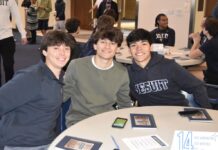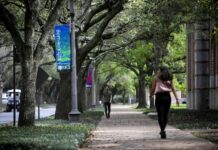Fifty pound medicine bags, nine students, six doctors, three days, two teachers, and one mission. Jesuit students were playing Uno on the filthy airport floor in Guatemala City, excitedly sharing their spring break plans and interest in medicine. Advised not to pet the wild dogs, they rushed into dented vans, roused by the deafening roars of motorbikes and the yells of vendors, and embarked on their four hour countryside drive, taking in the foreign landscape zooming past their cracked windows. The reason? Medical Society’s 2018 trip to Guatemala.
It started in the fall, when Jesuit students were asked to participate in the Jesuit’s Medicine Drive and to consider donating specific medications or toiletries assigned to one of their classes. Most students assumed these products were for local impoverished areas, but didn’t realize the more global impact of their generosity.
This year marked the 16th year of Jesuit’s Medicine Drive, an annual event hosted by Medical Society, Jesuit’s largest club in terms of student involvement. Led by Mr. von Schlenhenried, Ms. Sanchez, and Ms. Boyle, Medical Society seeks to pique the interest of curious students and introduce them into the professional medical field through the offering of biomedical classes, clinical rotations, and even mission trips. In the past, these trips have globally spread into various different countries including Honduras, South Africa, and Nicaragua, but more recently, the society has stationed itself in Guatemala, specifically the rural area of Sololá.
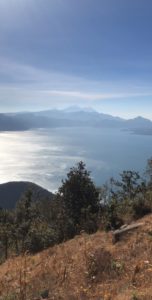
9 students took part this year, each of them being assigned a 50 pound duffel bag of the medicine donated this past fall by Jesuit students. The bags contained many over-the-counter drugs like ibuprofen and cough suppressants, but also things like eye drops, vitamins, and toothpaste, commonly unavailable to Guatemala’s rural areas.
From March 4th until March 8th, students received the priceless experience of shadowing doctors, while also immersing themselves in Guatemalan culture, and spreading Jesuit’s message striving to be Men for Others. The main mission of Medical Society’s Medicine Drive was to further this message of serving others by putting it on a global plane, while still providing educational benefits for the students. Seniors Carson Christensen, Flavio Calderon, Ryan Macalanda, Luke Wyand, Daniel Nguyen, with juniors Vaughn Camp, Marco Campioli, Taran Jain, and Kota Ueshima travelled to Sololá, Guatemala this spring to spread this message.
Spending most the days working in makeshift clinics, students assisted the doctors and dentists, while receiving a hands-on learning experience in the medical field. Each day, students chose two rotations to involve themselves with in order to help treat the local patients and learn more about the field. This year, the traveling team of medical professionals consisted of Dr. Paty Lesczynski, Dr. Yolanda Brady, Dr. Rhonda Walton, Dr. Tim Robinson and Dr. Justin Moseley, both dentists and graduates of Jesuit, as well as Ms. Kathy Bennett, the on-site social worker, and Nurse Shane. The on-site pharmacy was managed by Ms. Sanchez and Mr. von Schlenhenried.
Each day, students and doctors loaded themselves into passenger vans and travelled up 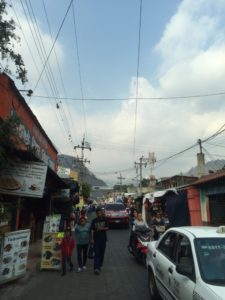 rocky, mountainous roads to reach the clinics, which were emptied schools often 45 minutes from where the trip’s participants were staying. These clinics were in rural villages where locals congregated in hopes of being treated. Being isolated from Guatemala’s larger cities and confined to the mountaintops, many of these patients spoke the local language, a deviation of Mayan, and Spanish translators were necessary.
rocky, mountainous roads to reach the clinics, which were emptied schools often 45 minutes from where the trip’s participants were staying. These clinics were in rural villages where locals congregated in hopes of being treated. Being isolated from Guatemala’s larger cities and confined to the mountaintops, many of these patients spoke the local language, a deviation of Mayan, and Spanish translators were necessary.
Students who worked at the triaging station (nursing) were the ones who admitted the patients. Students learned how to take blood pressure, temperature, analyze urine tests, and assign each patient to the appropriate doctor. Along with the medical aspect of this station, was the conversational side, meaning students practiced their Spanish and how to appropriately speak with patients. Once patients had been admitted, they visited the doctors.
Taran Jain, one of the participating juniors, said this station was his favorite because he “learned to communicate and interact with the native people,” also saying his opportunity to “use the spanish [he] had learned in school” only made this area even more enjoyable.
Dr. Rhonda Walton headed the pediatric branch of this trip, meaning her primary focus was the treatment of children. Students who worked with her monitored heart beats, breathing patterns, and ear canals of the local children, ranging from newborn babies to pre-teens. Dr. Paty Lesczynski managed the family medicine arm of the clinics. As someone who specializes in family medicine, Dr. Lesczynski monitors the health of both adults and children, meaning the students who worked with her learned about the care of children as well as adults, and how to properly diagnose their symptoms and prescribe appropriate medication.
Kota Ueshima, a junior, said this was his favorite rotation as he enjoyed “get[ting] to know the patient and then attempt[ing] to find cures.” Dr. Yolanda Brady, the internal medicine specialist, gave students an insight into the world of adult medicine and the monitoring of common pathologies among adults.
Along with the general doctors came the dentists. Dr. Tim Robinson and Dr. Justin Moseley, first time participants of Medical Society’s annual immersion trip, educated students of the importance of proper dental hygiene as well as providing hands-on demonstrations. Students served as dental assistants, aiding the dentists by retrieving tools and suctioning up blood and saliva from the mouths of patients. The dentists demonstrated how to apply proper anesthesia to oral regions, as well as allowing students to observe tooth extractions and proper suturing of open wounds.
Students were also granted to opportunity to manage and work in the pharmacy, which was a camping tent packed with the medicines students had carried through the airport in their huge duffel bags. Once doctors had prescribed medicine to patients, they visited the tent with a written form of what they needed. Mr. Von and Ms. Sanchez, fluent spanish speakers, conversed with the patients, telling them how and how often they should take the medicine, while also teaching the students about sanitarily managing medicine as well as the importance of correct dosages. Students used these skills to pack the medication for the locals.
Needless to say, this year’s trip to Guatemala immersed students in a learning environment far from the typical classroom experiences they’re used to in Texas. Along with deepening their understanding of primary care, students also furthered their appreciation for being Men for Others, a main tenet of Jesuit life. Junior Taran Jain added that the trip was 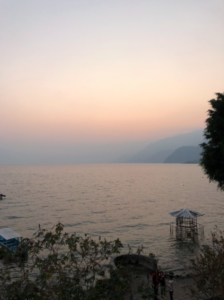 “a once in a lifetime experience where [he] got to explore medicine” and “selflessly serve another community,” which is something he is very passionate about. The isolation from their typical lunchtime conversations and their social media profiles gave students a deeper understanding of what service is, allowing themselves to fully embrace it, free of distraction. Actively engaging with patients and committing 10 hour work days, the students of this trip embodied the ideal of service above self as well as created friendships with Guatemalan natives and fellow Jesuit students.
“a once in a lifetime experience where [he] got to explore medicine” and “selflessly serve another community,” which is something he is very passionate about. The isolation from their typical lunchtime conversations and their social media profiles gave students a deeper understanding of what service is, allowing themselves to fully embrace it, free of distraction. Actively engaging with patients and committing 10 hour work days, the students of this trip embodied the ideal of service above self as well as created friendships with Guatemalan natives and fellow Jesuit students.


